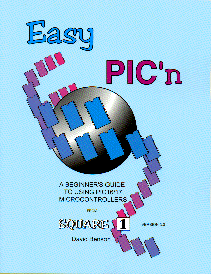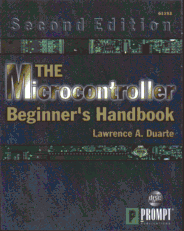
This beginner's book teaches the basics of how to get started programming PICmicro microcontrollers. Focusing on the PIC16C84 and 16C54, this guide shows how to write code for the PICmicro through the use of the Microchip assembler. The assembler converts English-like readable instructions into machine language understood by the PICmicro microcontroller.
PIC16/17's are not easy to write code for by hand because they are not intuitive. Many instructions require setting or clearing a bit to specify the destination for the result of executing the instruction. This is OK as an initial learning experience, but would become tedious very soon. So use of power tools is essential.
Learning about the PIC16/17's inner workings is possible once the use of the power tools is understood. The object of this book is to make this process as easy as possible. Once you get through this and you have programmed a 16C84 for the first time, a whole new world awaits. You will be able to create more interesting projects and have more fun!
160 pages.
 The PICProto S1 prototyping board is specially designed for working with the circuits in "Easy PIC'n" and "PIC'n Up the Pace".
The PICProto S1 prototyping board is specially designed for working with the circuits in "Easy PIC'n" and "PIC'n Up the Pace".

"PIC'n Up The Pace" picks up where "Easy PIC'n" left off. This book consists mainly of application examples, including the use of shift registers, serial EEPROMS, serial communications, LCDs, keypads, various sensors, analog to digital and digital to analog conversion.
This intermediate level book assumes you have either read "Easy PIC'n" or have other experience with PICmicros.
270 pages.
 The PICProto S1 prototyping board is specially designed for working with the circuits in "Easy PIC'n" and "PIC'n Up the Pace".
The PICProto S1 prototyping board is specially designed for working with the circuits in "Easy PIC'n" and "PIC'n Up the Pace".

 PIC'n Techniques - PIC Microcontroller Applications Guide - $34.95
PIC'n Techniques - PIC Microcontroller Applications Guide - $34.95"PIC'n Techniques" is an intermediate level applications guide covering Microchip Technology's PICmicro microcontrollers. This book describes the unique features of the 8-pin microcontrollers. The use of timer 1, timer 2 and the capture/compare/PWM (CCP) module is detailed, followed by timing, counting and pulse width modulation (PWM) experiments. These experiments include producing a single time interval output, free running pulse output, event counting, time measurement, frequency measurement and PWM. Some of these techniques are illustrated further by experiments which show how to design and build simple digital pulse and frequency generators and time interval and frequency measurement instruments.
The book also explains how to establish serial communication between a PICmicro chip and a PC via a RS-232 conversion circuit and a terminal program. These techniques are used in a digital voltmeter/data logger experiment for uploading data to a PC for display plus graphing using a spreadsheet program. "PIC'n Techniques" illustrates techniques used in designing and building intermediate level microcontroller-based instrumentation and systems.
310 pages.

This handbook examines all elements of microcontroller use, including such industrial considerations as price vs. performance and firmware. A wide variety of third-party development tools is also covered, both hardware and software, with emphasis placed on new project design.
This book not only teaches readers with a basic knowledge of electronics how to design microcontroller projects, it greatly enhances the reader's ability to repair such devices. There are even many ideas and hints for an experienced microcontroller user. When done, the reader will be able to design, write and build a new project utilizing a microcontroller.
246 pages. Includes CDROM.

 Programming and Customizing the BASIC Stamp Computer - $34.95
Programming and Customizing the BASIC Stamp Computer - $34.95This guide gives you a comprehensive tutorial on the easy-to-use BASIC Stamp single-board computer, which runs a PIC microcontroller, and doesn't require you to do any assembly programming. Written by the original author of the widely read "Stamp Applications" column for Nuts & Volts magazine, Programming and Customizing the BASIC Stamp Computer offers you:
As the PicBasic and PicBasic Pro Compilers use the BASIC Stamp instruction set, the information and examples in this book can be very valuable.
284 pages. Includes CDROM.